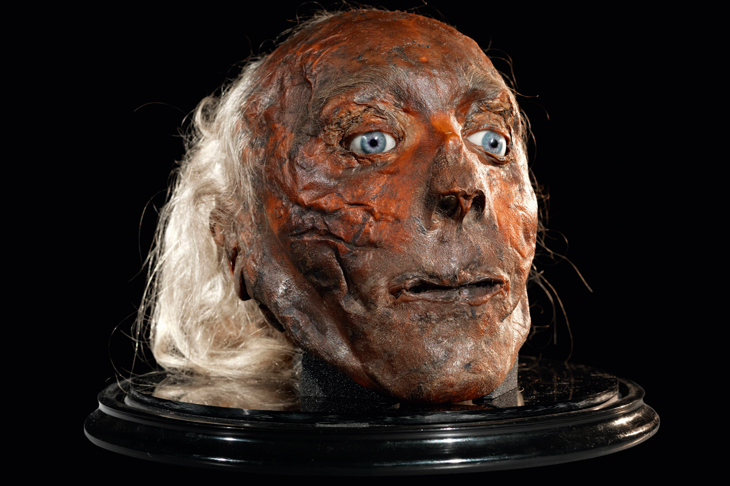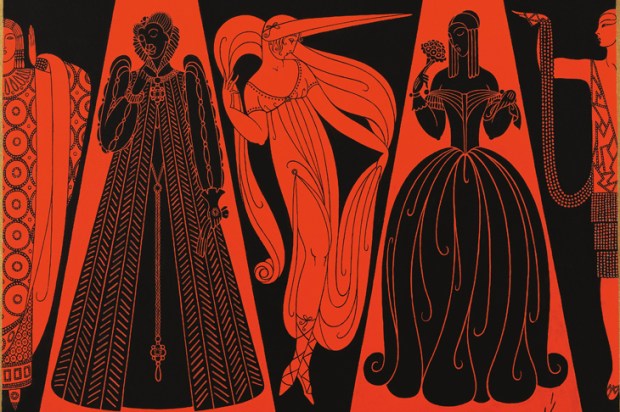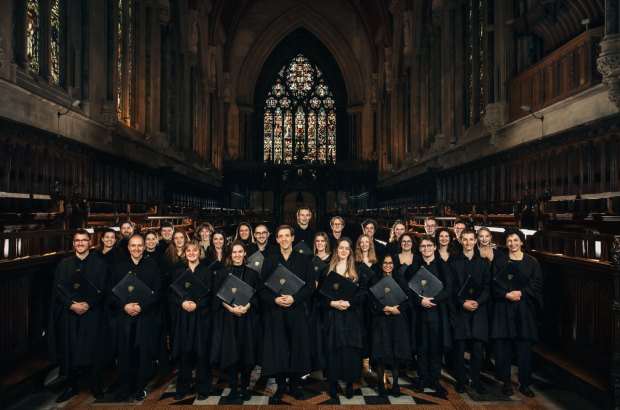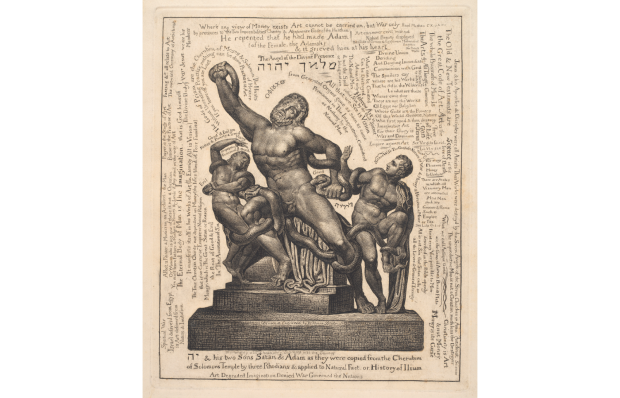Under the central dome of UCL — an indoor crossroads where hordes of students come and go on their way to lectures and lunch — there’s an intriguing exhibition on at the moment about death. ‘Human remains are displayed in this exhibition’, it says in white lettering on the floor atall four entrances, to warn any passing snowflakes.
The real head of Jeremy Bentham, who died in 1832, glass eyes staring out at you from behind a vitrine, is indeed a bit queasy-making. This is the central object of the exhibition. Bentham still has his long dark-grey hair at the back and sides of his bald pate, and his whole head is leather-brown from the tanning treatment after his death. He looks as if he’s grinning or grimacing. You can see the deep clamp marks in his cheeks from when his head was held in position and suspended over a vat of sulphuric acid for preservation purposes.
At least, for today’s more sensitive undergraduates, this is the head of someone who ticks all the virtue boxes. Bentham, the ‘spiritual founder’ of UCL, was an all-round good egg: against slavery, the death penalty and physical punishment, and in favour of animal rights and the legalisation of homosexuality. He was also a utilitarian and an atheist, and it was these two convictions that led him to stipulate in his will that his body should be delivered to a medical school and used in the furtherance of medical understanding of diseases.
Flinders Petrie, the Egyptologist whose collection forms the core of UCL’s Petrie Museum of Archeology, is another matter. Petrie’s head is not actually in this exhibition, as it lives in a jar at the Royal College of Surgeons, and that is perhaps a good thing, as it might have started a ‘no-vitrining’ riot. A quarter of the exhibition is nonetheless devoted to Petrie and his eugenicist ways. Petrie (d.1942) was an obsessive head-measurer, his favourite tool a ruler-like craniometer. ‘Petrie wrongly believed,’ the touchscreen tells us, ‘that skull size and facial features related to a hierarchy of moral virtues, faults and intelligence.’ In other words, he set out to prove (wrongly, the exhibition emphasises) that white people had larger heads than non-white people and were therefore superior. In his will, Petrie stipulated that he wanted his own head to be preserved for medical research as an example of the British ‘type’.
A slightly disjointed exhibition? Perhaps. But it’s meant to get us thinking about dead human heads and what we can learn from them, and whether we ourselves will want to fill in an ‘I wish to donate my body after death’ form, one of which is on display. No euphemisms for ‘died’ are used here: ‘death positivity’ is the message. To get us into the mood, we start with Victorian photographs of the newly dead, part of the 19th-century craze for relics. There were 11 displays of ‘hair work’ at the Great Exhibition: exquisite plaits of deceased beloveds.
Bentham led the way towards putting the dead human body on a dissecting table rather than a pedestal. He coined the term ‘auto-icon’ to describe a preserved body after death — and you can see the rest of Bentham’s skeleton, all padded with hay and smartly dressed, in a cabinet down the corridor. In the year of Bentham’s death, the Anatomy Act of 1832 came into force, making it possible for medical schools to use unclaimed bodies from hospitals and workhouses for research, when up to then they had only been allowed to use thebodies of executed murderers. Gray’s Anatomy of 1858, now in its 41st edition, was made possible by this act.
So, what on earth can we do, scientifically speaking, with Bentham’s head today? Well, UCL scientists, in tandem with the Natural History Museum, have used a sample of bone powder from one of Bentham’s teeth as a primary source, trying to see whether they can extract his DNA and work out, just from the tooth, what colour eyes he had. The honest answer, frankly expressed by the curators, is that they couldn’t. They managed to extract vast amounts of DNA, 473 pages of the stuff all printed out on computer paper, but it turned out to be mostly the DNA of the bacteria inside Bentham’s mouth. The only intrinsic fact his own tooth’s DNA revealed was that he was male. All that sulphuric acid and tanning treatment, it seems, did lasting and degrading damage to his DNA. The good news about the mouth bacteria was that it was very healthy bacteria — and so it should have been,as Bentham was treated by the royaldentist.
The only minor bore that mars this engaging exhibition is that you sometimes have to jab the touchscreens hard, again and again, in order to get them to react. It’s almost as if they, too, are dead.
Got something to add? Join the discussion and comment below.
Get 10 issues for just $10
Subscribe to The Spectator Australia today for the next 10 magazine issues, plus full online access, for just $10.
You might disagree with half of it, but you’ll enjoy reading all of it. Try your first month for free, then just $2 a week for the remainder of your first year.














Comments
Don't miss out
Join the conversation with other Spectator Australia readers. Subscribe to leave a comment.
SUBSCRIBEAlready a subscriber? Log in